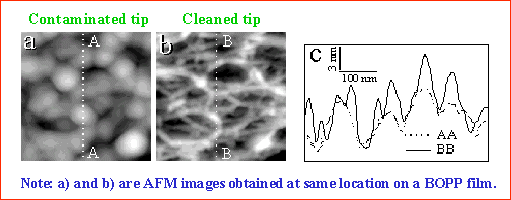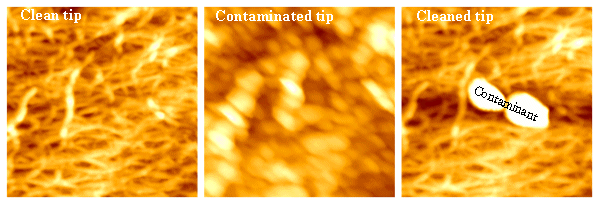H.-Y. Nie
An atomic force microscopy (AFM) image of a surface is constructed through the detection of an interaction between the tip apex and the surface features. The interaction, whether it be a contact force, an oscillation amplitude or others, is the feedback signal used to adjust the proximity of the tip and the surface features. Because of this imaging mechanism, an AFM image is, in practice, a convolution of the tip geometry and the surface features. Based on the actual geometry, the tip apex or the surface feature, whichever is sharper, acts as the effective probe. In practice, there could be a large-sized contaminant on the tip apex, making sharper surface features the effective probe. Therefore, images collected using a contaminated or damaged tip can be dominated by the geometry of the AFM tip itself (i.e., self-imaging of the tip) if the surface features are sharper than the tip.Interpretation of such images can easily be misleading if the tip effect is not taken into account. To ensure that the tip is “good” enough for imaging a surface, one needs reference samples that have known surface features, suitable for checking the tip performance. Introduced here is a simple and effective method of evaluating tip performance by imaging a biaxially-oriented polypropylene (BOPP) film, which is characterized by nanometer-scale sized fibers. The BOPP film surface is appropriate for use as a reference because a contaminated tip will not detect the fiber-like network structure. Imaging the very fine fiber-like structure of the BOPP film surface is a good criterion for the tip performance.

Because the polymer film is soft compared to the silicon tip (Young's modulus for polypropylene is 1-2 GPa, while for silicon it is 132-190 GPa), the polymer will not damage the tip when the tip is pushed into the polymer. This property can be used to clean a contaminated tip, i.e., by pushing the contaminated tip into the polymer, contaminants could be removed from the tip apex. Another important property of the BOPP is that the polymer film is highly hydrophobic and has a very low surface energy of ~ 30 mJ/m2 (The surface energy for Si is ~ 1400 mJ/m2; and the surface tension of water is 72 mJ/m2). These properties prevent contaminants from accumulating on the surface and hence prevent the contamination of the tip in the evaluation process.
Considerable effort has been expended to mathematically extract the geometry of the tip based solely on an algorithm derived from a given image. The method is known as blind reconstruction. This methodology is based on an assumption that protrusions in the AFM image represent the self-image of the tip, which is equivalent to the statement that sharper features on the sample surface act as the probe to image the AFM tip. This method has proven useful and successful in estimating tip geometry from an existing image, when appropriate samples were chosen (i.e., some surface features on the sample are sharper than the tip). Once the tip geometry is known, the tip effect may be subtracted from the original image through the mathematical operation of erosion, also known as deconvolution. Dilation is another mathematical operation, which adds a tip effect to an existing AFM image by “scanning” the known tip across the “surface” of the image. This transformation appears useful in simulating tip effect to a given image, because the mechanism of AFM can be regarded as a dilation between the tip geometry and surface features of the sample.We have found that a BOPP film is suitable for checking tip performance and for cleaning contaminated tips, thus making it possible to collect images of the same area of a BOPP film surface before and after the tip was cleaned. Therefore, the difference between the two different images is solely due to the contamination of the tip. We took advantage of our ability to collect AFM images of the same area using the same tip, in one instance, contaminated and, in the other, after being cleaned.
Commercial software SPIP (Metrology Image ApS, Denmark) was used to estimate the tip geometry using its “tip characterization module”, in which the blind reconstruction algorithm is implemented. First we used blind reconstruction on the image collected using the contaminated tip. Blind tip reconstruction allows one to extract the geometry of the tip from a given image. Once we had estimated the geometry of the contaminated tip, we used it to simulate the tip effect using the image collected using the cleaned tip. By comparing the simulation result with the image collected using the contaminated tip we showed that the blind reconstruction routine works well. Prior to this, there was no de facto method for testing blind reconstruction algorithms.
Comparison of tip geometry from the blind reconstruction method and from scanning electron microscopy (SEM) images has been made by Dongmo et al. We provides a simpler way to test blind reconstruction: comparison of AFM images collected in the same area of the BOPP by clean and contaminated tips. If the estimation of the contaminated tip geometry is reasonable, then one expects to be able to use the estimated tip geometry to dilate the image collected using the clean tip to obtain an image resembling one collected using the contaminated tip. Conversely, one can also determine if the deconvolution works by eroding the image collected with the contaminated tip using the estimated tip geometry to see whether the result resembles the image collected using the clean tip.
Because an AFM image is a convolution of the surface features and the tip geometry, if neither of them is known, there is no way to know, on an unknown sample, if the image is dominated by the surface features or the tip effect. When the tip is much sharper than the surface features, it will collect an image reflecting the “true” surface features. This is the reason why a reference sample is essential to check the tip performance. It is important to note that a tip could be easily contaminated or damaged depending on the chemical and mechanical properties of the sample surface. Using electron microscopes one can evaluate the outlines of the tip shape from specific directions, but it is difficult, if not impossible, to capture the three-dimensional geometry of the tip.
In combination with blind reconstruction, using BOPP film to check the tip performance provides a simple and effective protocol to test the estimation of the tip geometry of a contaminated tip. One can do this by comparing the image collected using the contaminated tip with the image generated by dilating the image collected using the clean tip.
On the other hand, when the tip is much larger than the surface features, using such a tip to scan the surface will result in an image that is merely a reflection of the geometry of the tip apex itself. In this case, it is evident that the information about the surface features is physically lost. Therefore, the erosion operation will not lead to the recovery of the “true” surface features, though the mathematic operation may result in an image which is likely closer to the “true” surface features. The degree of the recovery by the erosion operation is dependent on how severely the tip is contaminated. One can imagine that different surface features can have similar images if a large tip is used: they are dominated by the tip effect.
H.-Y. Nie, M.J. Walzak and N.S. McIntyre, "Atomic Force Microscopy Study of Biaxially-Oriented Polypropylene Films", J. Mater. Eng. Perform., 13, pp.451-460 (2004). H.-Y. Nie, M.J. Walzak and N.S. McIntyre, "Use of biaxially-oriented polypropylene film for evaluating and cleaning contaminated atomic force microscopy probe tips: An application to blind tip reconstruction", Rev. Sci. Instrum. 73, pp.3831-3836 (2002). H.-Y. Nie and N.S. McIntyre, "A simple and effective method of evaluating atomic force microscopy tip performance", Langmuir 17, pp.432-436 (2001). {This paper was highlighted in April 1, 2001 issue of Analytical Chemistry }
Peter Markiewicz's web page MikroMasch's SPM probes
P. Markiewicz and M.C. Goh, Langmuir 10, 5 (1994). J. Vesenka, R. Miller, and E. Henderson, Rev. Sci. Instrum. 65, 2249 (1994). J.S. Villarrubia, Surf. Sci. 321, 287 (1994). P. Markiewicz and M.C. Goh, Rev. Sci. Instrum. 66, 3186 (1995). P. Markiewicz and M.C. Goh, J. Vac. Sci. & Technol. B 13, 1115 (1995). S. Dongmo, M. Troyon, P. Vautrot, E. Delain, and N. Bonnet, J. Vac. Sci. & Technol. B 14, 1552 (1996). P.M. Williams, K.M. Shakesheff, M.C. Davies, D.E. Jackson, C.J. Roberts, and S.J.B. Tendler, J. Vac. Sci. & Technol. B 14, 1557 (1996). J. Vesenka, T. Marsh, R. Miller, and E. Henderson, J. Vac. Sci. & Technol. B 14, 1413 (1996). M.F. Tabet and F.K. Urban, J. Vac. Sci. & Technol. B 15, 800 (1997). J.S. Villarrubia, J. Res. Natl. Inst. Stan. 102, 425 (1997). L.S. Dongmo, J.S. Villarrubia, S.N. Jones, T.B. Renegar, M. Postek, and J.F. Song, Ultramicroscopy 85, 141 (2000). B.A. Todd and S.J. Eppell, Surf. Sci. 491, 473 (2001).